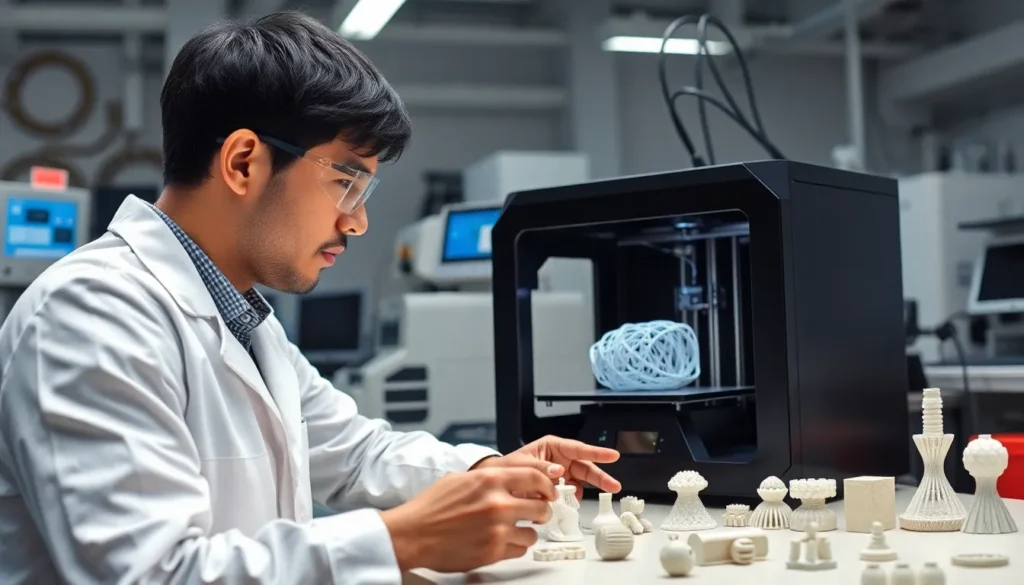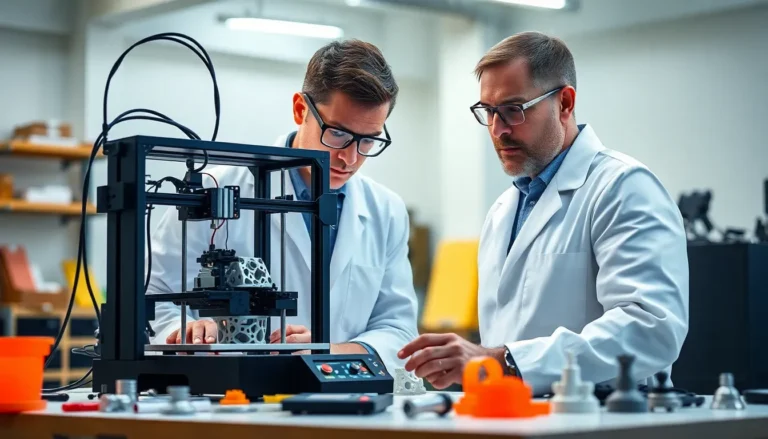In a world where creativity knows no bounds, innovative 3D printing is the magic wand transforming ideas into reality. Imagine printing your dream gadget while sipping coffee in your pajamas. Sounds like a sci-fi movie, right? But this technology is here to stay, reshaping industries from healthcare to fashion and everything in between.
Table of Contents
ToggleOverview of Innovative 3D Printing
Innovative 3D printing reshapes traditional manufacturing methods by allowing the creation of complex designs not feasible with conventional techniques. This technology enables customization, letting users tailor products specifically to their needs. Various industries, such as healthcare, utilize 3D printing to produce personalized medical devices, prosthetics, and even organ models for surgical planning.
Materials used in 3D printing have evolved significantly, including metals, ceramics, and biocompatible substances. Such advancements improve durability and functionality in end products. The fashion industry benefits greatly from 3D printing, as designers can experiment with intricate patterns and shapes, leading to unique apparel and accessories.
Production speed also increased due to innovative techniques like continuous liquid interface production (CLIP) and multi-material printing. These methods shorten the time from design to finished product, facilitating rapid prototyping. Cost-effectiveness remains another key advantage, making it accessible for small businesses and startups.
Sustainability plays a crucial role in shaping the future of this technology. By minimizing waste and using recyclable materials, 3D printing embraces eco-friendly practices. Research continues to explore how 3D printing can reduce carbon footprints in various sectors.
Collaboration between industries and technology is essential for the ongoing development of 3D printing solutions. Partnerships between designers, engineers, and manufacturers drive innovation forward. As such, innovative 3D printing stands at the forefront of a manufacturing revolution, enabling new possibilities across diverse fields.
Applications of Innovative 3D Printing

Innovative 3D printing finds extensive applications across various sectors, driving significant transformations and enhancing operational efficiencies.
Healthcare
Healthcare benefits substantially from innovative 3D printing. This technology enables the production of personalized medical devices and prosthetics tailored to individual patient needs. Surgeons utilize 3D printed models for precise pre-operative planning, improving surgical outcomes. Biocompatible materials used in the production of implants enhance patient comfort and safety. Additionally, pharmaceutical companies explore 3D printing for customizing medication dosages. Increased accuracy in medical applications demonstrates the critical role of 3D printing in advancing healthcare solutions.
Manufacturing
Manufacturing processes gain efficiency through innovative 3D printing. This technology facilitates rapid prototyping, allowing manufacturers to develop and test product designs quickly. Companies reduce material waste by employing additive manufacturing techniques, which utilize only the necessary amounts of raw materials. Customization of parts becomes feasible, leading to products aligning closely with consumer demands. As manufacturing evolves, 3D printing supports the creation of complex geometries that traditional methods cannot achieve. Ultimately, this flexibility enhances competitiveness in the market.
Aerospace
Aerospace industries embrace innovative 3D printing for its lightweight and strong materials. Components produced through this technology reduce overall aircraft weight, improving fuel efficiency. Engineers design intricate parts that optimize aerodynamics and performance, which conventional manufacturing could not efficiently replicate. Production timelines shorten, accelerating project completion while maintaining high standards of safety and quality. Moreover, the ability to create spare parts on demand minimizes inventory costs and storage needs. This application showcases the potential of 3D printing in revolutionizing aerospace design and manufacturing practices.
Advantages of Innovative 3D Printing
Innovative 3D printing offers numerous advantages that transform various industries.
Cost Efficiency
Cost efficiency represents a primary benefit of innovative 3D printing. This technology significantly lowers production costs by minimizing waste and reducing material expenses. For small businesses and startups, the affordability of 3D printing makes it easier to enter the market. Rapid prototyping saves resources and time, enabling faster iterations and product improvements. Comparatively, traditional manufacturing often entails high setup and tooling costs, which can be prohibitive. Through on-demand production, inventory costs decline, as businesses can produce items only when needed. Overall, cost efficiency enhances competitiveness and encourages innovation.
Customization
Customization stands out as a key advantage of innovative 3D printing. This technology allows for tailored products that meet specific user needs, making it particularly valuable in healthcare. Personalization of medical devices and prosthetics improves patient outcomes and satisfaction. Designers in the fashion industry use 3D printing to create unique apparel, driven by individual preferences. Beyond aesthetics, customization enables complex geometries that traditional manufacturing methods cannot achieve. As a result, both consumers and businesses gain access to products that reflect their style or requirements. Innovative 3D printing truly elevates the potential for personalized solutions across various sectors.
Challenges in Innovative 3D Printing
Innovative 3D printing faces several challenges that could impact its growth and applications.
Material Limitations
Materials used in 3D printing can restrict its potential. Not all materials offer the required strength or durability necessary for specific applications. Some metals and biocompatible substances may struggle with structural integrity under stress. Limited material options can hinder the production of high-performance components. In healthcare, for instance, the effectiveness of personalized medical devices relies on biocompatible materials that ensure patient safety. Designers often seek versatile materials to expand creative possibilities and enhance functionality. Current research focuses on developing new composites that blend various properties to meet industry demands.
Regulatory Issues
Regulatory environments pose another hurdle for 3D printing adoption. Various sectors require compliance with specific safety and quality standards. In healthcare, regulatory bodies like the FDA scrutinize medical devices for safety and efficacy before approval. This lengthy approval process can delay product launches and innovations. Manufacturers face challenges in proving their 3D printed products meet established guidelines. Ongoing discussions among industry professionals seek to create standardized protocols that simplify the approval process. Collaboration among stakeholders can enhance compliance and foster innovation within the industry.
Future Trends in Innovative 3D Printing
Emerging technologies continue to shape innovative 3D printing. Increasingly, companies adopt bioprinting techniques to create living tissues, pushing the boundaries of medical science. Advancements in materials science lead to stronger, more versatile filaments that enhance product capabilities. Integration of artificial intelligence streamlines design processes and reduces errors during printing.
The trend of modular design becomes prominent, allowing for easy customization and assembly of 3D printed parts. Sustainability practices evolve, incorporating bio-based and recycled materials that minimize environmental impact. Focus shifts toward on-demand production, which eliminates excessive inventory and reduces waste.
Collaboration among interdisciplinary teams accelerates the development of novel applications. Industries, including automotive and construction, explore new methods that leverage 3D printing for prototypes and components.
In the education sector, innovative 3D printing serves as a vital tool, providing hands-on learning experiences for students in engineering and design fields. Increased availability of affordable 3D printers enables wide access to this technology, sparking creativity among hobbyists and entrepreneurs.
Regulatory bodies work on establishing clearer guidelines, facilitating smoother approval processes for new products. Efforts to improve post-processing techniques enhance the quality and finish of 3D printed items, making them more appealing to consumers.
Opportunities for personalization continue to rise, especially in consumer goods and fashion industries. The growing popularity of digital marketplaces allows designers to showcase and sell custom 3D printed products, expanding market reach. Without a doubt, innovative 3D printing holds the potential to redefine manufacturing, healthcare, and beyond in the coming years.
Innovative 3D printing is set to revolutionize multiple industries by merging creativity with functionality. Its ability to produce customized solutions not only meets individual needs but also enhances efficiency and sustainability. As technology advances and material options expand, the potential applications will continue to grow.
Collaboration among designers, engineers, and manufacturers will drive further innovation, paving the way for breakthroughs in healthcare, fashion, and beyond. The future of 3D printing promises to be exciting and transformative, unlocking new possibilities that were once thought to be unattainable. Embracing this technology will empower businesses and individuals to create a more sustainable and efficient world.



